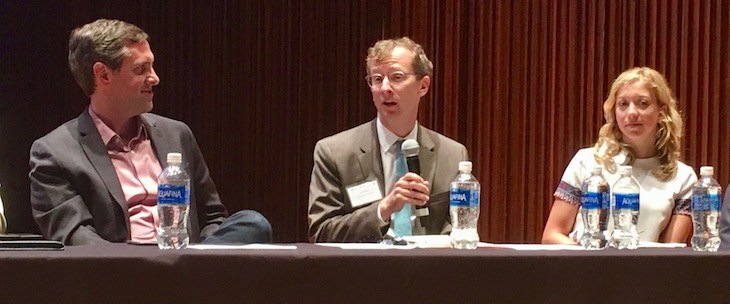Panel: Thriving economies can spring from just one or two cultural ‘anchors’
by June 1, 2017 7:49 pm 1,082 views

(from left) Rep. Greg Leding, D-Fayetteville, Walton Family Foundation representative Joe Randel, and Tulsa Artist Fellowship program director Julia White participate in a panel on place-making and the importance of arts.
Research shows just one or two cultural “anchors” in an otherwise underdeveloped commercial neighborhood can spark a thriving creative economy, a marketer said Thursday (June 1) during a roundtable discussion on place-making and the arts at the Jim & Joyce Faulkner Performing Arts Center on the University of Arkansas campus in Fayetteville.
“All it takes is one restaurant to open in a place like downtown Springdale or south Fayetteville, and it can set off a chain reaction,” said Bryce Harrison, associate creative director at CJRW in Springdale.
Popular businesses can attract others, and a thriving neighborhood can draw more development, resulting in the establishment of a cultural hub that serves as an economic driver for the region as a whole, said Rep. Greg Leding, D-Fayetteville. It’s not going to happen on its own, he said.
“It has to be very conscious, very deliberate. Place-making should be woven into every policy consideration.”
At the same time, it’s not a top-down process, Leding said. While state policy can carve out opportunities, “a lot of it is done on a local level.”
Arts funding is not often at the top of the Legislature’s priority list in Arkansas — one of the poorest states in the U.S. — especially now, during a trend toward budget tightening, and for that reason it’s important to continue to demonstrate the importance of art in the community and its benefits to the community, Leding said.
In fact, the Chronicle of Higher Education reported that arts education added $7.6 billion to the nation’s gross domestic product in 2011, said Todd Shields, dean of the J. William Fulbright College of Arts and Sciences at the UA. The report also showed for every dollar consumers spend on fine arts, an additional 56 cents is generated elsewhere in the community. Total spending on arts and cultural goods and services was about $1 trillion in 2014, according to a report released in April by the Bureau of Economic Analysis. Economic activity in the industries accounted for 4.2% of the U.S. gross domestic product, or $730 billion, according to the BEA.
Anna Clark, marketing and events manager at Northwest Arkansas Council, said the arts and culture scene is integral to her work recruiting people to the area through Finding NWA. More than half the NWA population is not native to the region, “and art is a real connection point,” she said. “World-class talent wants access to art. … It brings a richness to life that’s incomparable to numbers.”
ART ACCESSIBILITY
Joe Randel, arts and culture program officer for the Walton Family Foundation’s Home Region program, said the foundation “believes in the power of the arts to mobilize and engage communities.” That is the strategy the foundation has applied in its work in the NWA region’s downtown districts.
“We’ve done extensive work in terms of providing access to the natural environment but also the built environment to make sure downtowns are a place where people love to live work and play.”
There, he said, art is a driving force, but that sort of community development requires cooperation from a number of sources, including business, government and nonprofit.
“It really is an ecosystem that takes all of us contributing all our parts to the equation,” Randel said. The Walton foundation is constantly looking for new partnerships to help “keep that momentum going.”
One challenge is accessibility, both for individuals to experience arts and for artists to live in a creative community.
“The affordability factor is something that we’re hearing loud and clear,” Randel said. However, the issue of affordable housing relies on a number of different factors that fall under the purview of different entities. But that doesn’t mean the Walton foundation is ignoring the issue, he added. “Those conversations are happening.”
Another panelist, Julia White, program director of the Tulsa Artist Fellowship, pointed to affordable housing as a key component of both her nonprofit organization’s artist residency program and the Brady Arts District as a whole in downtown Tulsa.
ART ‘ECOLOGY’ ISSUES?
Patrick Ralston, director of the Arkansas Arts Council, said his organization is focused on the “ecology” of artists throughout the state of Arkansas, stating that both artists and arts organizations are needed to form an arts community.
He asserted a lack of business training for some Arkansas artists, in addition to a gray area between hobby artists and those whose primary livelihood is in art, has made art an “underground economy” in some ways — paid in cash and off the radar.
“In order to make a place for these artists, you have to teach them to function as part of the economic fabric of the community,” Ralston said. “That’s a goal I’m working toward.”
A longtime professional artist in the audience, Leilani Law, said she objected to Ralston’s comments, which she considered to be promoting a narrative of “the starving artist.” Fine art photographer Sabine Schmidt, a member of the audience for the panel discussion, said there are other challenges for the arts economy.
“What also needs to be addressed is the rampant bad habit of asking artists to work for free — designing posters, submitting photos, donating artwork, putting up entire exhibitions, and so on — all for ‘exposure,’” she said, referring to projects not in the realm of select pro bono nonprofit work. “It needs to go both ways: artists should be aware of the business side of their profession, and businesses should treat — and pay them — as professionals.”
